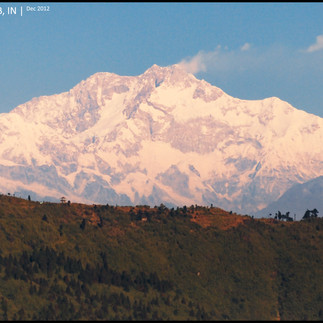Kurseong & Dow Hills - This is Home
- SALENSA [Saikat Sarkar]
- May 8, 2021
- 7 min read
Updated: May 9, 2021
KURSEONG
“The Land of White Orchids”. And the land of fairytales. My lasting memories of Kurseong (Kharsang to the locals) are the walks through the wooded forests to school. The town is a small sub-divisional headquarter about 30Km from Darjeeling on the Hill Cart Road. At one time, in the distant past, the town was small enough for everyone to know everyone. This is no longer the case. But it still is a charming little town – a bit dirty may be – but once you are away from the main town, and are either headed towards Darjeeling on the Hill Cart Road, or towards Makaibari Tea Estate on the Pankhabari Road or towards Dow Hills further up, the nature of the place changes completely.
In addition to being an erstwhile “health resort” (it used to have the only TB Sanatorium in the district), Kurseong is probably now the school capital of Darjeeling district. With the success of numerous boarding schools in the eighties, the town has since seen a proliferation of a large number of schools, catering to the population of the entire North East, West Bengal and Bihar. The big four schools are Goethal’s Memorial School, St. Helen’s School, Dow Hills Girls High School, and Victoria Boys’ High School. In the late eighties, a large number of new schools were opened by extremely competent teachers of these original four, which now provide good quality education to the large section of the populace at a reasonable price.
So what can you do when you are at Kurseong? Well, my views are that of a person who lived there for 6 years, in an era, where there were no televisions or internet. Hence the small pleasures the town offered, were what were priceless.
A sample:
Lovely momos at any of the small shops in town, or at the Kurseong Tourist Lodge. Pork momos are the best. In the eighties, the best momos could be had at a ramshackle joint called Milan's. But that establishment has since shut shop.
You can walk or take a cab down to Makaibari Tea estate, spend the day at the Tea Factory, and spend a lot of money on your way back, when you buy some of the finest Darjeeling tea in the world. And remember, if you do buy some of that tea, please do not boil the tea in milk. Brew the tea. Feel the aroma and the flavor. If you are a “cutting chai” person, this tea is not for you.

You can walk into the railway station canteen, and see how one of the smallest and quaintest railway stations in the world function, while you munch on “bred-omlet’. I only wish that the station was cleaner. It would have been charming. Now you will have to ignore the filth to feel the charm.
You can sit for hours at the chowrasta in front of the railway station and see the world go by.

Or you can take a full day trek up to Dow Hill, and just enjoy the fact that you are alive in one of the most beautiful places on earth.
In the days of past, there were hardly any hotels in Kurseong. Over the years, quite a few have come up including Cochrane's place, Nirvana Retreat, a few homestays, and of course the new Taj property at Makaibari (though the last one is not strictly Kurseong, its in the lower reaches of the Tea Estate). Nevertheless, with a few good resorts, Kurseong is now to Darjeeling what Coonoor has been to Ooty.
DOW HILL
When one reaches Kurseong, one can feel justifiably proud of reaching a high in life at all of 4864 ft (as is prominently displayed on the façade of the Kurseong Railway Station). But if you feel that you want more, you should head further upwards from Kurseong town. Just take the road up from the Railway Station, past the post office and town library, and past Raj Rajeshwari Girls High School, and keep going uphill, until you reach a place called Dow Hill. It is a place which many locals call Heaven.
Dow Hill is about 5km from Kurseong town, on a fairly steep road, and offers an excellent full day trek to a visitor to Kurseong. Once you reach Dow Hill, you will be transported to another world. A world of fog and mist, of tall pine tree woods, of beautiful colonial buildings and bungalows – mostly belonging to the local schools and the Forest Department. I mean they own both the woods and the bungalows.
The history of how this place came to be known as Dow Hill is sketchy. Popular belief is that it is named after a bird, which was quite common in this place. But please don’t hold me to this information. As I said, this information is sketchy. However, the interesting fact is that Dow Hill is renowned to be the second most haunted place in India (after Bhangarh in Rajasthan). This was not known to me when I used to live there, and I have never seen anything supernatural in the hills, though, we used to live in a bungalow named Gurans (Nepali for Rhododendron), which had many a skeleton of wild animals shot by game seekers of the past.

Having lived at Dow Hills for four years, my belief is that, this place was developed by the colonials due to the similarity of the environment, climate and “feel” of “back home England”. Not that I am an expert on this, since I have never been to “back home England” (except for a brief 2 hour layover at Heathrow, which I am sure doesn’t count). But the place had, and still has, a distinct fairy tale feel to it. For a young and impressionable mind, the woods of Dow Hill was no different from the woods of Red Riding Hood, or Snow White and Seven Dwarfs etc. Walking the 2 km to school, through those beautiful jungle paths, sucking on the nectar of the flowers (yep, we actually did that), or eating wild berries, or the wild nuts that the monkeys would throw at us just to annoy us, it surely felt that you were in one of those fairy tale stories. And of course you had the odd chance of spotting that fox in the woods, to make that feeling more real.

This is the place where we learnt to walk jungle paths with heavy footfalls to scare away snakes. This is the place where we used to walk with small sacks of salt during the rains, to rid ourselves of the leeches that would cling onto us sucking pour blood. This is the place where a 4 km uphill journey back home used to be done on the trot in approx. half an hour. Much of the charm and romance still remains. Some of the woods are now out of bounds, since some bright minded person has decided to create a “deer park” by blocking off part of the pristine paradise. The rest of the place, though, remains unblemished. You should visit this place for its gorgeous views of the Himalayas, for a walk through the pine forests and for the smell of the pine needles on the forest floor.
I have lived in 3 homes in Kurseong - two in Dow Hills, and one which is not technically Dow Hills, but in St. Mary's, which is about a few 100 ft below Dow Hills at a place called Eastern Forest Rangers' College. The walk from Dow Hills is St. Mary's is awesome. One other "to do" could be a walk down the chorbato (jungle trail) from Dow Hills to Goethal's Memorial School, and then a walk across the hill road to St. Mary's to EFRC and finally climb up the unmetalled road back up to Dow Hills. If you do this at least twice during your stay in Kurseong, I can guarantee weight loss and increase in stamina.
If you are adventurous enough, and have access to a vehicle, then you should drive up the Old Military Road from Dow Hill to Bagora, and even further up to Chatakpur. If you o early in the morning, then you will be able to see the first rays of the sun on Mt. Kunchenjungha, without the rush and crowd of Tiger Hill in Darjeeling. For all you know, you will be the only person watching the sun rise.
Bagora is a tiny little village (it still is) with a few homes and and Air Force Station. Its as remote as it can get, and is situated on the eastern ridge of the Kurseong-Jorebungalow Ridge. Unlike from Kurseong, where you can see the Mahananda and Balason valleys, from here you can see the Teesta valley and Dooars beyond. You will find my adventurous drive up this Eastern face in my Latpanchar drive blog here.
Dow Hills has got two good schools – both government run. Dow Hill School for Girls (though it is co-ed till prep school), and Victoria Boys’ School. The forest department also has a Forester Training School in Dow Hills.
Unless you are lucky to get a booking at either the Forest Rest House at Dow Hills or at one of the guest houses of the two schools, you will have to stay either at Kurseong town, and trek up to this place, or book yourself into Nirvana Retreat in Deorali, which is a short walking distance from Dow Hill. In any case, carry food and water for the day. You will find many lovely picnic spots along the way, or in the forests when you reach Darjeeling. Or you can request some of the local villagers to cook you some fresh food. And every small village will have at least one tiny momo and thukpa stall. Always, pork variants are the best.
Each season has its own beauty in Kurseong and Dow Hill. Winters are bitterly cold, but often awash with bright sunshine and crystal blue skies. Spring and autumn are the best - flowers bloom all across the landscape, and locals decorate their homes with lovely colourful gardens. May to September is often gloomy, wet, foggy and rainy. But that too has its own charm. The fun of sitting in front of a crackling fire, dry, safe and warm inside, when it is a whiteout outside with visibility of barely 1 meter, is something to be experienced. Beware that this place still has limited net connectivity, and hence it will not be difficult to fall off the grid for a few days, and you will be transported to a different era altogether. All in all, a corner of the world, that is not to be missed.

























































Comments